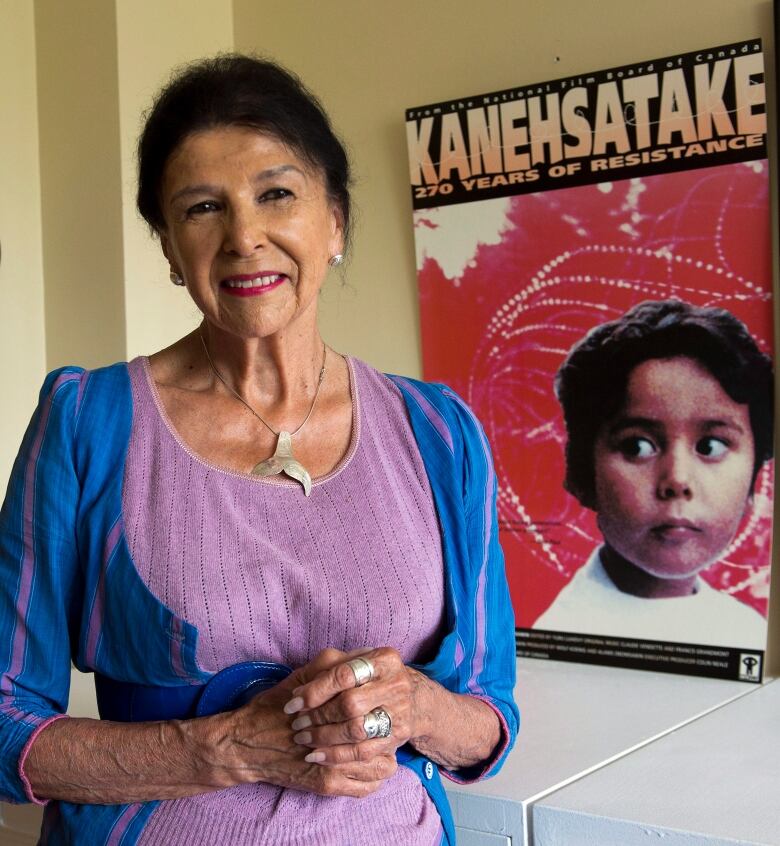Oka Crisis deepened understanding of land claims in Canada
25th anniversary dredges up difficult memories for those involved

It was a crisis that grabbed international headlines,with Mohawks and Canadian soldiers involved in a lengthystand-off that often appeared on the verge of exploding intofull-blown combat.
Twenty-five years on, the legacy of the Oka Crisis for many ofthose who experienced the tension west of Montreal is a greaterawareness of indigenousissues.
- TIMELINE: 78 days of civil unrest
- Filmmaker Alanis Obomsawin: behind Mohawk lines
- LISTEN:Mohawk barricades went up 25 years ago
In 1990, when the town of Oka decided it was going to allow theexpansion of a golf course on disputed territory including on aMohawk burial ground people living in the neighbouring Mohawkcommunity of Kanesatake rose up in defence of what they said was their land.
In response to the council's decision, Mohawks barricaded a dirtroad leading to the golf course.
After they refused to obey a court injunction to stand down, ashootout ensued with provincial police officers and resulted in thedeath of Cpl. Marcel Lemay onJuly 11.
Where the bullet came from remains a mystery.
Army called in
The Quebec government called in the Canadian Forces and roughly800 members of the Royal 22e Regiment encircled the Mohawks in thepines with barbed wire.
"[Premier Robert Bourassa]called us into his office the dayafter (the shooting) and told us he made it clear, he didn't wantany more death," Sam Elkas, who was the Quebec public security ministerat the time, said in an interview.
After 78 days of negotiations, both sides struck a deal: thebarricades made of dirt and mangled police vehicles were to comedown in return for the cancellation of the golf course expansion.
The disputed territory remains an unsettled issue, however, andwas never officially ceded by the Mohawks or handed over to theKanesatakeby federal or provincial governments.
"You reach a point after a while where you have to make astand," Kanesatake resident Linda Simon, who experienced theviolence, said in an interview.
"The common lands had slowly been given away and sold and therecame a point where people weren't going to take it anymore."
Legacy of the crisis

Alanis Obomsawin, an award-winning filmmaker who made amuch-praised documentary about the conflict called "Kanehsatake:270 Years of Resistance," said the events of 1990 inspired indigenouspeople across the country and raised awareness among Canadiansregarding land claims.
"When I go out West, [aboriginal]people tell me, 'Alanis, wecould never thank the Mohawks enough for what they did."'
Back home, Quebec Aboriginal Affairs Minister Geoffrey Kelleysaid provincial and federal governments have appreciated since Okathat First Nations groups need to be consulted when developmentprojects affect their territory.
"Back then I think we would have acted more unilaterally," hesaid.
Kelley mentioned provincial funding for the Kateri Memorialhospital on the Kahnawake reserve south of Montreal which he saidrequired several bureaucratic hurdles to overcome such asmodifications to labour laws as an example of a change ingovernment attitude towardIndigenous Peoples.
"It's a small example but a good one to show how we are adaptingour institutions with native realities and I think they will bringgreat benefits in the future," he said.
But while indigenous people have received more respect fromnon-indigenousgovernments since Oka, there are many outstanding landclaims across the country, and some Canadians still harbourprejudices against Aboriginal Peoples, Kelley said.
Difficult memories
Tom Siddon, federal minister of Indian Affairs and Northern Development at the time under Brian Mulroney, said he believes Okaplayed a key role in improving the thorny issue of land claims.
"I think we were able to make some major progress and I dobelieve that Oka was an important turning point in our naturalhistory," he said in an interview.
The current grand chief in Kanesatake says that while the MohawkWarriors might have inspired people around the world, the aftermathof the crisis led to the "social disintegration of the community."
Oka is what happens when dialogue stops.- Serge Simon, grand chief of Kanesatake
Serge Simon said it has taken a generation for people to overcomethe trauma of the crisis and band council politics have onlyrecently started to calm down after years of tension and sometimesviolence between community members.
Simon said the 25th anniversary of the crisis has forceddifficult memories to the surface including what he called
human-rights abuses he alleges his people suffered at the hands ofthe provincial police.
"[The provincial police]took my cousin Angus Jacob and broughthim to the back of a barn and handcuffed him to a metal chair," hesaid in an interview.
"They pulled his pants down and they started electrocuting histesticles to get him to talk."
He said events like Oka can happen again in Canada but it'scritical that indigenousand non-indigenous people continue to talk to oneanother.
"Oka is what happens when dialogue stops," he said.












_(720p).jpg)


 OFFICIAL HD MUSIC VIDEO.jpg)
.jpg)



























































































